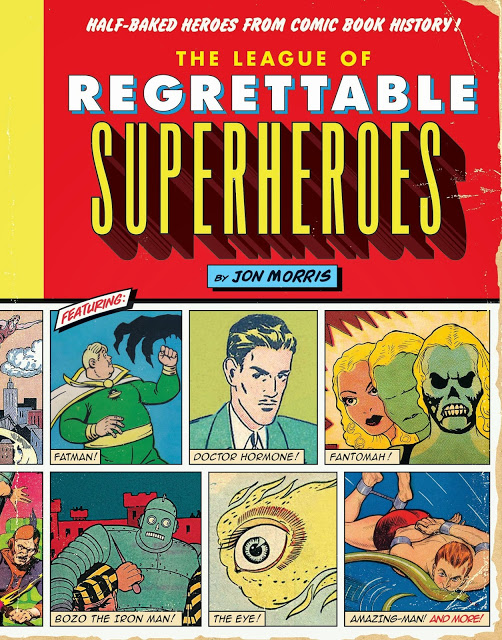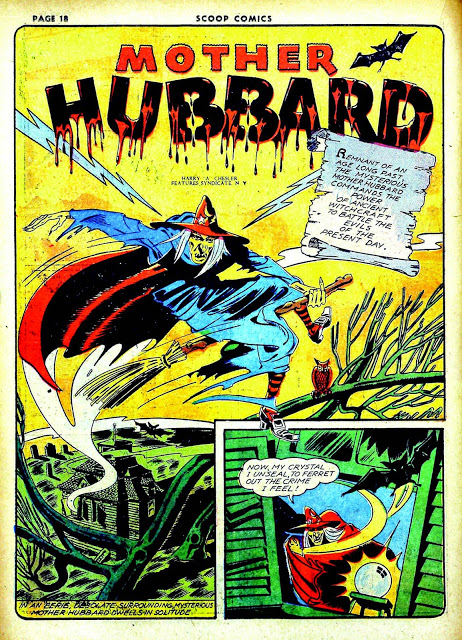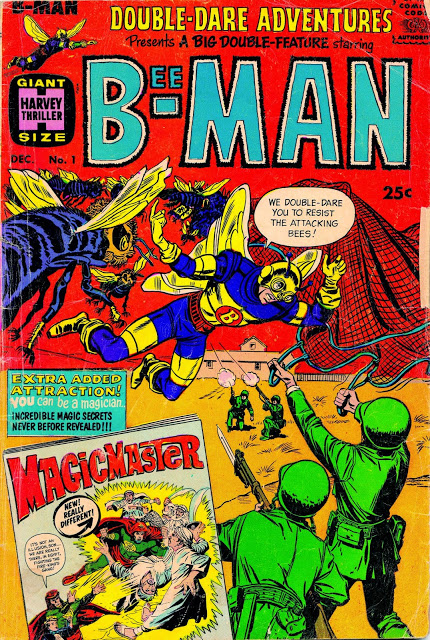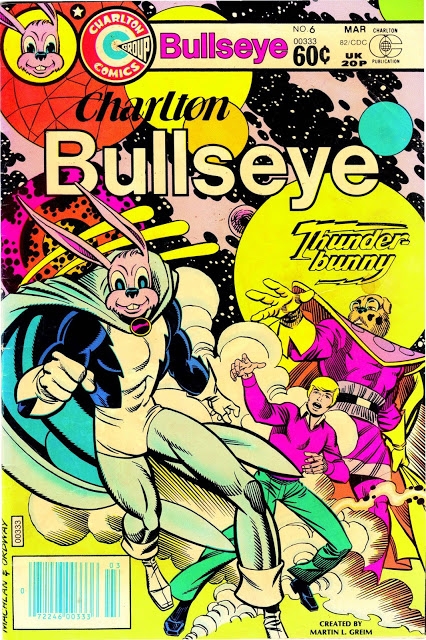With the recent surge of caped crusaders flying, swinging, and leaping from comic book pages to the big and small screens, a revival of the classic superhero is clearly under way. But for every Batman, Green Arrow, or Flash, there’s a slew of forgotten superheroes who failed to become household names.
Jon Morris, cartoonist and graphic designer, began cataloguing the often-strange history of comics in the 1990s on his blog Gone & Forgotten. In 2001, his work was featured on a popular This American Life episode about failed superheroes. Now, The League of Regrettable Superheroes: Half-Baked Heroes from Comic Book History (Quirk Books; June 2, 2015; $24.95) will guide readers through comic book history’s top 100 mighta-beens, oddballs, and freaks of the past eighty years. Visually stunning from cover to cover, the book is divided into three eras, all of which feature dazzling comic art from the period:
- The Golden Age (1938–1949): Superman’s first appearance in Action Comics #1 launched the superhero phenomenon. Comics publishers filled stands everywhere with primary-colored heroes to capitalize on the popular genre. Their experiments included some epic failures, including Atoman, Doctor Hormone, The Eye, Lady Satan, and many more!
- The Silver Age (1950–1969): After a brief dip in popularity (due mostly to the oversaturated market), superheroes came back with a BANG! The high-camp spirit of the ’60s and the beginnings of a new technological age changed how superhero stories were told. With newfound energy and wit, masked heroes such as Bee-Man, Captain Science, Spyman, and Pow-Girl tried to reach a younger, hipper audience.
- The Modern Age (1970–Present): Beginning in the ’70s, comics shifted toward darker, more serious storylines, creating a “grim and gritty” universe. Ridiculous new superheroes like Brother Voodoo, Man-Wolf, The Outsiders, and Squirrel Girl attempted to address real-world issues, including drug abuse and civil rights, solidifying a new trope in comics—though their tenures were short-lived.
Each section includes a treasure trove of entertaining (though flawed) superheroes, complete with backstories, gorgeous vintage art, and witty commentary from Morris. Die-hard comics fans, superhero movie lovers, and pop culture fanatics will gush over this comprehensive tome.
After the jump, check out an exclusive excerpt from the book which includes the introduction and a profile of a hero from each heroic age.
Superheroes are big!
Contemporary culture has embraced superheroes in a major way. Hardly a month goes by without an announcement about the release of a new blockbuster superhero movie. Superhero television shows are all over the airwaves, with more waiting in the wings. Superheroes populate our video games, advertising, clothing, and collectibles—even home furnishings. You can make your bed with superhero sheets and light your house with superhero lamps.
Perhaps this ubiquity should come as no surprise. When superheroes burst onto the scene almost eighty years ago, they captured the public imagination like nothing before. Bold, distinctive, and sometimes bizarre, the four-color caped crusaders quickly leapt from drugstore comic book racks to newspapers,radio, movie theaters, and television. True, their popularity has had its ups and downs. But however you look at it, brightly colored defenders of right and goodness like Captain America, Superman, Wonder Woman, and Spider-Man have become household names. Even once-obscure characters like the X-Men or Guardians of the Galaxy have achieved silver screen success.
Still, not every Spandex-clad do-gooder manages to make the big time. From the very origins of the genre to the newest digital graphic novels, the family tree of costumed crimefighters includes hundreds of third-stringers and Z-listers: near-misses, almost-weres, mightabeens, nice tries, weirdos, oddballs, freaks, and even the occasional innovative idea that was simply ahead of its time.
In the pages that follow, you’ll meet largely forgotten heroes, those who walked away from their comic book careers without so much as a participation ribbon to show for it. They are some of the most intriguing also-rans in comics history: super-centaurs, crime-fighting kangaroos, modern-day Draculas, shape-changing spaceships, and even an all-powerful disembodied flying eye. We call these second-tier (or lower) superheroes “regrettable,” but it’s important to remember that none of these characters are inherently bad. Sometimes, the only factor that kept them from succeeding was bad timing, an unstable marketplace, or merely being lost in the crowd. There’s not a single character in this book who doesn’t have at least the potential to be great. All it takes is the perfect combination of creative team and right audience to make even the wildest idea a wild success.
In fact, several members of the League of Regrettable Superheroes have been revived, revamped, reintroduced, or otherwise regifted with a new lease on life. A few are attempting a comeback even now. In comics, there’s always a chance that a seemingly vanished character will come back from extinction. With superheroes becoming more popular with every passing day, you never know when a once-regrettable hero might return and become the next media sensation—or at least find devoted fans among a whole new generation of comics readers.
To count these heroes out and consign them to oblivion without appreciating what they represent—evolving notions of heroism, insights into comics history, and a sampling of fantastic fashion trends in cape-and-cowl ensembles—well, that would be truly regrettable.
MOTHER HUBBARD
“Loosen eyes from out of head, no more children you’ll be fed.”
Created by: Unknown
Debuted in: Scoop Comics #1 (Harry “A” Chesler Publishing, 1941)
Sidekick: Technically, shouldn’t she have a dog?
© 1941 by Harry “A” Chesler Publishing
Despite bearing a name with origins in a children’s nursery rhyme (admittedly, a somewhat bleak one), Mother Hubbard’s trio of adventures in the early 1940s may have been the most flat-out terrifying superhero stories in the entire genre. Back then, everyone in a cape and cowl fought a few Nazi masterminds. Only Mother Hubbard confronted a race of gnomes who pried the eyes out of children’s heads with a crowbar!
Mother Hubbard was part of a small sorority of magical superheroines (sorcerous do-gooders were not uncommon, but male magicians outnumbered their female counterparts by far), but she stands out from the rest by being a genuine witch—crone-like appearance, peaked hat, flying broomstick, and all. Headquartered in a dilapidated house located somewhere inside a morose swamp, bordering a graveyard and a forest of barren needle-like trees—evidently on the indistinct boundary between the real world and a world of mystical horrors—Mother H turned the tools of witchcraft against the forces of evil, both human and supernatural.
“A remnant of an age long past,” begins the caption to her introductory tale, “the mysterious Mother Hubbard commands the power of ancient witchcraft to battle the evils of the present day.” Her occult armory was a cupboard that wasn’t bare but, rather, full of ominously labeled bottles of “bat’s claws,” “siren’s lure,” “madman’s blood,” and the like. With these, she worked her “idle black magic.” She was also in possession of a crystal ball, and Mother Hubbard could tell when evil was afoot via a built-in series of biological early warning systems. As she once explained, in the rhyming speech that was her trademark patter: “My nose is twitching, my blood runs cold, ’tis sign of pending crime that I must unfold.” She could also count on her creaking bones and curling hair to alert her to imminent wrong-doing, although for most folks such bothersome symptoms just mean it’s going to rain.
Although she debuted fighting Nazis, Mother Hubbard more often fought bizarre supernatural menaces whose targets were children. In one adventure, work-avoidant gnomes steal the souls of sleeping kiddies and use them to animate tireless wooden dolls to labor on their behalf. In a subsequent adventure, Mother Hubbard blinds a trio of baby-eating ogres and disrupts a subsequent black market for stolen human child’s eyes (the gnomes were also responsible for that horrifying operation).
Our heroine appeared in a few more comics, but those stories were reprinted from her original run in Scoop. No new Mother Hubbard stories have popped up since. Maybe she’s busy restocking her cupboards.
Editor’s Note: Harry “A” Chesler’s comics were known particularly for publishing wild and weird stories. Allegedly, when asked what the “A” stood for, Chesler replied, “Anything.” Formerly employed in the furniture business and advertising, heoversaw a packed studio of high-quality comics creators. His employees churned out stories that were then sold to other comics publishers; Chesler also oversaw a chain of publishing houses under variations of his own name, where heroes like Lady Satan (page 76) and the Black Dwarf (page 19) debuted. Chesler claimed at one point to have supplied superhero adventures for 300 comics titles.
BEE-MAN
“We double-dare you to resist the attacking bees!”
Created by: Otto Binder and Bill Draut
Debuted in: Double-Dare Adventures #1 (Harvey Comics, December 1966)
Headquarters: The Hive (a giant hive)
© 1966 by Harvey Comics
With the arrival of Batman to the nation’s television screen in 1966, Bat-Mania soon followed. Pop culture went bananas for all sorts of costumed crime-fighters, no matter the flavor. Comics enjoyed a surge of popularity and renewed creativity, and the freshly fertile earth produced literally dozens of over-the-top campy characters. If a premise could be beaten into the ground, comics were there to do it.
Take, for example, Bee-Man. His story begins as disgruntled mission control technician Barry E. Eames (note the initials) sabotages the landing of a remote-controlled rocket ship, intending to rob the sample-gathering space vessel of whatever wonders it has collected from beyond the surly bonds of earth. Unfortunately, what Eames finds inside the vessel are mutant space bees, which mercilessly savage him and drag his broken body to their distant world.
After an interlude in outer space, Eames returns to earth, decked out in technologically advanced armor from the Bee People’s impressive new fall collection of comfortable casualwear for would-be space thieves. The unstoppable Bee-Man occupies himself by stealing gold, radium, and lifegiving honey. He stores the loot in his secret, hidden Houston Astrodome–sized beehive headquarters. Surely no one would ever be able to find such a structure, particularly if they were suffering from “Giant Hive Blindness.”
Yes, Bee-Man begins his career as a super-crook. By the second issue, however, he’s turned himself around, pointing his supersonic wings, honey grenades, and nose-mounted stinger for the cause of justice. Shocked and unsettled by the Bee People’s plans to enslave the minds of all humanity (you might even say he was bee-side himself), Bee-Man turns on the Bee Planet’s beautiful but cruel “Queen Bea” and aligns himself with the Federal Bureau of Investigation. Officially serving as a superpowered defender of the planet, Bee-Man gains the additional honor of a position as a government operative—yes, he’s awarded special-agent status in the one-man “F-Bee-I”!
Bee-Man’s career on the side of right was sadly abbreviated. (Or should we say a-bee-viated? No, we probably should not.) After just two appearances, Double-Dare Adventures was canceled and Bee-Man was forced to turn in his wings.
THUNDERBUNNY
“I have great power, but I become a rabbit to use it? I don’t know if being a superhero is worth it!”
Created by: Martin Greim
Debuted in: Charlton Bullseye #6 (Charlton Comics, March 1982)
Other career options: Delivering Easter eggs; outsmarting hunters with speech impediments
© 1982 by Martin Greim
The long-lasting appeal of superheroes can be attributed, at least in part, to their inherent escapism, especially for young readers. Kids can imagine themselves decked out in a colorful costume and possessing all those wonderful powers, gadgets, and skills. Some heroes, like the original Captain Marvel, capitalize on that sense of wonder by having the hero transform from a child into a superpowered champion.
Such a transformation happens to Bobby Caswell, adolescent comic book fan, when he stumbles across a crashed spaceship. The ship’s sole denizen—the last survivor of a doomed civilization—passes on to Bobby the power of his planet’s greatest hero. All Bobby must do is concentrate, clap his hands, and he is transformed—into a giant pink rabbit clad in Spandex!
It’s an absurd turn of events, though not a completely raw deal. While inhabiting the form of Thunderbunny, Bobby gains tremendous strength, is invulnerable to harm, and can move and fly with the speed of lightning. The one drawback (aside from looking like Bugs Bunny on steroids): the longer he remains in Thunderbunny’s impressive cartoon-headed form, the more difficult it is to return to his human self. Bobby Caswell runs the risk of becoming an anthropomorphic bunny for life!
Bobby’s superheroic career straddled an impressive line between spoof and homage. Facing foes like Doctor Fog, Snaka (an evil snake sporting cybernetic arms), and the robotic Big C.A.M., he also found the opportunity to team up with fellow superheroes the Mighty Crusaders, the THUNDER Agents, and even an assortment of obscure Golden Age heroes like Pat Parker, War Nurse (page 99) and Magicman (page 162).
Thunderbunny was one rabbit who had trouble finding a permanent hutch. The character originally appeared in fanzines—small-run magazines printed, edited, and distributed by comic book fans—before landing at Charlton Comics. When that company sold its stock of superheroes to DC Comics, Thunderbunny suddenly became homeless. Red Circle, a superhero-friendly imprint of Archie Comics, provided an early home, as did Warp Graphics. Thunderbunny then hopped over to Apple Comics, where his luck finally ran out.
Thunderbunny hasn’t popped up since then, but it’s comforting to know that—as of his final appearance—Bobby hadn’t yet been permanently trapped in the form of his lagomorphic alter ego.













































































































